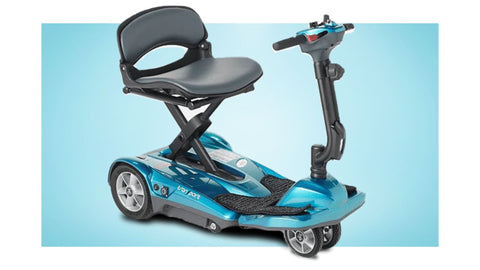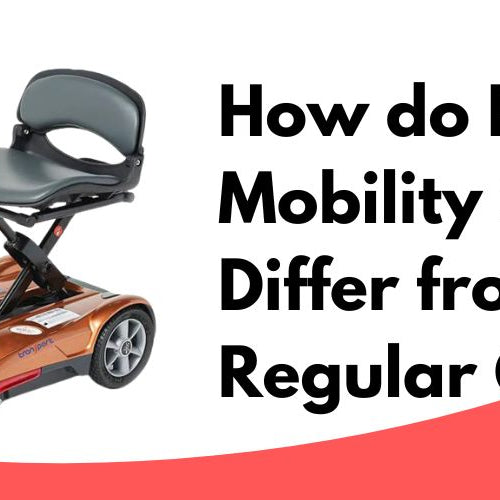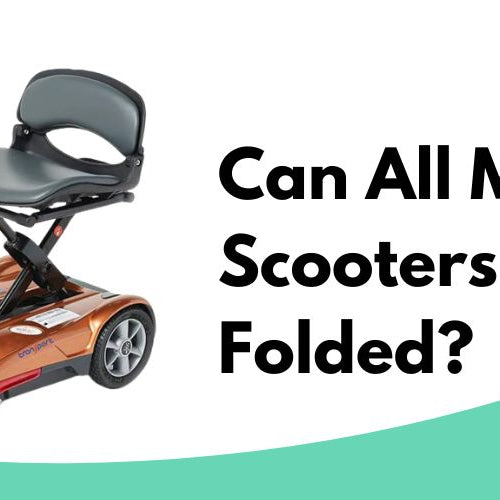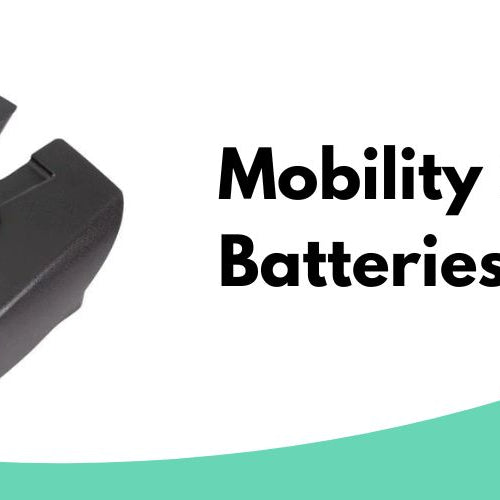Mobility scooters have significantly improved the lives of those with limited mobility, granting a level of independence that can be life-changing. The innovation in this space has led to the development of folding mobility scooters, a subcategory designed with portability in mind. Unlike traditional mobility scooters, which are often larger and more robust, folding mobility scooters are lightweight and compact. They cater to users prioritizing ease of transport, especially those who frequently travel or need to store their scooter in tight spaces.
The design of folding mobility scooters focuses on the simplicity of collapse and convenience, ensuring they can be easily stowed in a vehicle's trunk or taken on public transportation. This portability aspect contrasts the regular models, which may need a specialized vehicle lift for transport. Despite being foldable, these scooters maintain essential features for safe and reliable operation, embodying the core purposes of stability, comfort, and assistance in movement.
While both types of scooters aim to provide freedom and autonomy to individuals facing mobility challenges, folding mobility scooters distinguish themselves through their adaptability in varying environments. Their innovation lies not only in providing mobility but in ensuring that this mobility isn't hampered by the transition between locations, whether it's moving from indoor to outdoor spaces or traveling between cities.
Design and Functionality
Folding mobility scooters exhibit distinct characteristics that differentiate them from regular scooters, focusing on foldability and ease of use without compromising functionality.
Mechanism of Folding
The folding mechanism of foldable mobility scooters is a pivotal design element that allows them to collapse into a more compact form. Various models offer manual or automatic folding systems; the latter provides a convenient, push-button operation that is advantageous for users seeking simplicity and minimal physical exertion.
Compactness for Storage
These scooters are designed to be compact when folded, making them ideal for storage in small spaces. The lightweight construction materials contribute to this feature, allowing the folded scooter to fit easily into car trunks, closets, or overhead storage bins on airplanes, enhancing portability.
Ease of Operation
The ease of operation of foldable mobility scooters is paramount—they typically require less strength and dexterity to operate compared to non-foldable models. The scooters often have easy to fold mechanisms and are designed to be intuitive, fostering independence among users.
Practical Features
Despite their folding nature, these scooters don't fall short on practical features. They might include adjustable armrests, swivel seats, and puncture-proof tires. The design of foldable mobility scooters aims to maintain function—such as sufficient battery range and stability—while being lightweight and portable.
Portability and Storage

When considering mobility scooters, portability and storage are significant factors. Folding mobility scooters offer notable advantages over non-folding ones, specifically regarding ease of storage and the convenience of transportation.
Storing at Home
Folding mobility scooters are an excellent choice for people with limited space at home. They typically collapse into a compact size, allowing them to fit into smaller spaces when not in use. For example, they can easily be stored in a closet or corner of a room without taking up excessive space.
Transporting in a Vehicle
The compact nature of folding mobility scooters when collapsed makes transporting them in the trunk of a car a much simpler task. They are designed to be lightweight, with some models having removable batteries to reduce weight further, making them easy to lift into and out of a vehicle. The convenience of a foldable scooter allows for quick disassembly and reassembly, saving time and effort during transport.
-
Weight (typical without battery): 40-60 lbs
-
Battery Weight (approx.): 15-25 lbs
Compatibility with Public Transport
Folding mobility scooters provide users with greater flexibility when traveling on public transport such as buses and trains. Due to their reduced size when folded, they usually meet the size requirements for public transportation, allowing users to bring their scooters aboard without inconvenience to other passengers. This travel mobility scooter can also be stowed easily on platforms or luggage areas within public transit systems.
It's important to note that some models even come with remote control features to aid in folding and unfolding, which can be particularly beneficial for individuals with limited dexterity or strength.
Performance and Comfort
Performance and comfort are critical factors when comparing folding mobility scooters to regular ones. They vary in speed, terrain adaptability, and built-in features that promote stability, which can significantly affect user experience.
Speed Settings
Folding mobility scooters typically offer adjustable speed settings, allowing users to choose the pace that suits their comfort and safety needs. Most models can reach a top speed of 4-5 mph. The speed control is straightforward, often featuring a dial or buttons on the tiller for easy adjustments.
Terrain Handling
Regular mobility scooters have a more robust build which usually allows for better handling on various terrains. They often come with larger tires and enhanced suspension systems. In contrast, folding mobility scooters might struggle with uneven surfaces due to their compact design and smaller wheels, making them more suited for smooth, flat environments.
Stability Features
The stability of a mobility scooter is imperative for user confidence and comfort. Regular scooters often feature a four-wheel design that provides greater stability, which is enhanced with wider wheelbases and anti-tip wheels. Folding scooters may incorporate special design elements like automatic speed reduction when turning to maintain stability due to their lighter frame and increased portability. Armrests are available on both types for additional support.
Battery Life and Charging
In folding mobility scooters, the battery life and charging specifics play a crucial role in ensuring efficient travel range and convenience for both indoor and outdoor use. Proper care and handling of the batteries can maximize performance and longevity.
Battery Types
Folding mobility scooters typically utilize two types of batteries: Sealed Lead Acid (SLA) and Lithium-ion. SLA batteries are cost-effective and have a robust design, but they are heavier and typically have a shorter lifespan than their lithium-ion counterparts. Lithium-ion batteries, on the other hand, are lighter, offer a longer travel range per charge, and have a longer life expectancy. For example, the Atto folding mobility scooter is known for its lithium-ion battery, which contributes to the scooter's light weight and ease of transportation.
Charging Requirements
When it comes to charging requirements, it is imperative to follow the manufacturer's instructions to ensure battery integrity. The charger should match the scooter battery's voltage and amperage specifications. It is generally recommended that users:
-
Charge after each use: To maintain optimal battery health and guarantee a full charge for the next ride.
-
Select the right charger: The voltage output of the charger must correspond to the scooter's battery (commonly 12V, 24V, or 36V).
-
Charge at room temperature: If possible, to maximize battery efficiency.
To preserve the battery's lifespan and prevent damage, one should avoid overcharging as well as depleting the battery completely before recharging. Users should also be aware of the recommended charging times—which can vary depending on battery size and charger output—ensuring that batteries are charged for at least 8 hours or until fully charged as indicated by the charger.
Specifications and Adjustability

When choosing a mobility scooter, it’s important to consider the technical specifications and how adjustable the scooter is to meet individual needs. Folding mobility scooters generally offer unique features that cater to an active lifestyle, including lightweight frames and components that are designed for easy adjustment and handling.
Weight Capacities
-
Folding Mobility Scooters: Typically lighter, they can support anywhere between 250 to 300 pounds.
-
Regular Mobility Scooters: Often built sturdier and can accommodate users up to 500 pounds or more.
The weight capacity of a scooter directly impacts its suitability for different users, ensuring safety and reliability.
Ground Clearance
-
Folding Scooters: They usually have lower ground clearance, which reduces their usability on uneven terrain.
-
Standard Scooters: Higher ground clearance makes them more versatile across various surfaces.
Ground clearance is a crucial factor for individuals who frequently navigate over curbs or uneven outdoor surfaces.
Adjustable Components
Tiller: The steering mechanism, or tiller, on mobility scooters is essential for comfortable operation. In both folding and standard models, tillers can be adjustable to fit the user's reach and preferred driving position.
- On folding scooters, the tiller is often designed to fold down along with the rest of the unit.
-
Regular scooters may offer more advanced adjustability options, like angle adjustments and height settings.
Adjustability across different components is vital for providing a tailor-made experience for each user, contributing to comfort and ease of use.
Safety and Accessibility
When considering mobility scooters, safety and accessibility are paramount. Folding scooters often integrate features to enhance user security and ensure they can access various environments with ease.
Safety Features
-
Anti-tippers: Folding mobility scooters typically come equipped with anti-tippers for added stability to prevent the scooter from tipping over backwards. This feature is crucial, especially when users navigate inclines or uneven terrain.
-
Speed Settings: These scooters may offer multiple speed settings, typically three, allowing users to adjust the speed according to their comfort level and the environment they’re navigating to maintain control and safety.
Ease of Access
-
Portability: The ability to fold enhances portability, enabling users to effortlessly transport the scooter in a car, bus, or train. This feature removes barriers to accessing diverse locations, whether they be urban or rural.
-
Compact Design: A foldable mobility scooter's design is often compact, facilitating easy storage and maneuverability in tight spaces, making them a more accessible option for those with limited home space or who frequently visit crowded places.
Cost Considerations
When considering a mobility scooter, it's important to assess both the initial outlay and the long-term expenses associated with the device. Folding mobility scooters often present a different cost profile compared to regular mobility scooters, both at the time of purchase and in their ongoing maintenance needs.
Initial Purchase Price
The initial purchase price for folding mobility scooters varies, generally ranging from $1,699 to $1,950 for mid-priced models. However, higher-end folding mobility scooters can start at around $1,995, with prices escalating based on features and brand. In comparison, regular scooters may come at a more varied price spectrum, but both options should be evaluated against the buyer's budget and specific mobility requirements. It's also worth noting that some purchasers may be eligible for tax deductions or subsidized rates on these devices, depending on local healthcare provisions.
Ongoing Maintenance Costs
Ongoing maintenance costs for mobility scooters are an important aspect of the overall investment. Folding mobility scooters may offer the advantage of reduced maintenance due to their design for easy storage and transportation. Nevertheless, they still require regular servicing to maintain safety and functionality. The rates for maintaining a foldable versus a non-foldable scooter might not differ significantly, but foldable models might incur additional costs if specialized parts are needed. Owners should consider these costs within their budget, and affordable maintenance should be a factor in the decision-making process.
Market Variety and Options
In the mobility scooter market, consumers are presented with a range of options differing in features and designs, catering to diverse needs and preferences. Two primary categories offer distinct choices: foldable mobility scooters for those prioritizing portability and regular models for those who may favor stability and power.
Top Brands and Models
The best folding mobility scooters are manufactured by companies that specialize in mobility aids, ensuring reliability and innovation in their designs. Choices range from basic models providing essential features to high-end scooters loaded with advanced functionalities.
Choosing the Right Model
When selecting a folding mobility scooter, buyers should consider:
-
Folding Mechanism: Look for a simple, hassle-free process. Some scooters offer self-folding capabilities, representing the apex of convenience.
-
Weight: A lightweight mobility scooter enhances portability. Determining the scooter's primary use will guide the weight preference—lighter scooters for frequent travelers or heavier ones for increased support.
Deciding on the right model involves matching individual needs with the scooter's specifications, ensuring the choice enhances the user's mobility and quality of life. Manufacturers like EV Rider and iLiving strive to create scooters that are not only functional but also integrate seamlessly into daily life.
Regulations and Airline Compliance
Folding mobility scooters offer increased convenience for travelers, but they must adhere to specific regulations and airline guidelines to ensure safe and compliant transport. The regulations focus on safety, particularly regarding battery type and capacity, which vary between domestic and international flights.
Domestic Travel
For travelers within a country, airlines commonly follow the federal aviation regulations for the transport of mobility devices. For example, under 49 CFR 175.10 (a)(17), there are conditions for traveling with a mobility device on an airplane. A critical aspect is the battery: airlines may permit lithium-ion batteries installed and protected in the scooter, but they often have an energy capacity limit, typically less than 300 watt-hours (Wh). When two batteries are used, each must commonly have a capacity of no more than 160Wh.
Travelers must inform the airline when they intend to bring a folding mobility scooter onboard. This courtesy allows the airline to prepare for its safe storage, whether in the cabin or as checked baggage. Additionally, batteries must often be removed and carried in the passenger cabin.
International Travel
International guidelines for folding mobility scooters tend to be more stringent and can vary widely depending on the airline and the involved countries. The International Civil Aviation Organization (ICAO) and the International Air Transport Association (IATA) set forth general guidelines, where the IATA recommendations are widely adopted.
A key requirement is that all lithium-ion batteries must undergo testing according to UN38.3, a standard that assures the safety of batteries during air transport. Compliance with these standards must be verifiable, often through a label on the battery. Beyond airline regulations, international travelers must also consider any specific country regulations that may apply upon arrival or departure.
For airline-approved travel, it's common that mobility scooters adhere to battery capacity restrictions, with a frequent upper limit being 300Wh or 160Wh for each battery if more than one is used. Passengers are advised to ensure their scooters meet the airline's specific certification and compliance requirements for international transport. It is crucial for travelers to check with their chosen airline prior to departure to confirm the exact policies as they may differ from standard practices.
User Experiences and Recommendations
When considering the purchase of a mobility scooter, potential buyers often turn to user experiences and expert recommendations to determine the best fit for their needs.
Customer Reviews
Pros of Folding Mobility Scooters:
-
Portability: Customers appreciate the ease of transporting folding mobility scooters. They conveniently fit into car trunks, which makes them ideal for travel.
-
Storage: Owners of foldable scooters frequently mention the benefit of compact storage, requiring minimal space in homes or when dining out.
Cons of Folding Mobility Scooters:
-
Price: Some reviews indicate that cost can be a factor, with foldable models often being more expensive than their non-foldable counterparts.
-
Durability: There are occasional mentions of concerns about the durability of lighter, foldable models compared to traditional scooters.
Traditional Mobility Scooters:
-
Stability: Reviews often highlight the stability and wide seat options that traditional scooters offer, contributing to a comfortable ride.
-
Battery Life: Users of traditional scooters commonly point out the longer battery life these models tend to have.
Expert Recommendations
Experts typically recommend folding mobility scooters for users who prioritize convenience and portability. They counsel consideration of:
-
Weight: An expert-recommended model like the EV Rider Transport Plus is noted for its lightweight design, weighing only 76 lbs, or 40 lbs with the battery removed.
-
Design Choices: A sleek, stylish design with color options is also often suggested to match the user's personal style.
For traditional mobility scooter users, experts suggest considering a model with a:
-
Wide Seat: For comfort during prolonged use.
-
Heavy-Duty Build: To accommodate a wider range of users and ensure longevity.
Purchasing decisions should always be informed by both reviews and expert advice, with a clear understanding of the intended use and the user’s physical needs.
Conclusion
Folding mobility scooters offer a blend of convenience and portability, a contrast to their non-folding counterparts. For those prioritizing ease of transportation and storage, foldable designs are advantageous. They generally require less space and can be disassembled quickly. This feature suits users who frequently travel or have limited storage.
Non-foldable mobility scooters, while not as portable, may provide greater stability and are often equipped for a variety of terrains. Their sturdier construction can be a deciding factor for users requiring a durable, everyday mobility solution.
Key Considerations:
-
Portability: Folding mobility scooters excel in portability, simplifying transit in vehicles and public transport.
-
Space: Foldable designs are revered for saving space, fitting into closets or car trunks effortlessly.
-
Stability: Non-foldable scooters may offer better stability and durability, suitable for varied terrain.
-
Price: Folding scooters can be more expensive, but the investment may be justified for those valuing portability.
In selecting between foldable and non-foldable mobility scooters, individuals should assess their unique needs, lifestyle, and budget. A folding mobility scooter is ideal for active users seeking flexibility, while non-folding models cater to those who require robustness and less frequent transport of the device. Prospective buyers should consider all options, perhaps even consulting with healthcare professionals, to ensure optimal mobility and independence.
Frequently Asked Questions
This section addresses common inquiries potential buyers and users have regarding the differences between folding mobility scooters and standard models.
What features make folding mobility scooters unique compared to standard models?
Folding mobility scooters are designed with a mechanism that allows them to fold into a more compact form. This feature enhances portability and ease of storage. They often have lightweight frames and are typically more straightforward to transport in vehicles or public transportation due to their reduced size when folded.
How do the stability and safety of folding mobility scooters compare to non-folding ones?
Folding mobility scooters are generally equipped with safety features similar to non-folding models but may offer a smaller footprint, leading to variations in stability. Their design must balance foldability with a sturdy structure to ensure users' safety. Some models may have limited ability to adjust seating posture, which can be a factor in both comfort and stability.
What should one consider when purchasing a folding mobility scooter for durability and reliability?
When assessing the durability and reliability of a folding mobility scooter, one should examine the quality of construction materials, the robustness of the folding mechanism, and the reputation of the manufacturer. Additionally, reviews or testimonials regarding the longevity of similar models can be informative.
Can folding mobility scooters accommodate similar weight capacities as regular scooters?
Most folding mobility scooters can support a comparable weight capacity to non-folding models. However, due to design constraints associated with foldability, some may have slightly lower weight limits. Users should check the specifications of the particular model to ensure it meets their needs.
What are the potential drawbacks of using a folding mobility scooter for everyday use?
For everyday use, folding mobility scooters may present challenges such as a less cushioned ride due to compact frames, fewer customization options for individual comfort, and potentially a shorter range if the model has a smaller battery to save on space and weight.
How does the performance of folding mobility scooters fare during travel or in varied terrain?
Folding mobility scooters are particularly advantageous for travel due to their ease of transportation. However, their performance in varied terrain may be less robust compared to some non-folding models, as they are often designed with portability in mind, which can limit wheel size and suspension quality.








Leave a comment